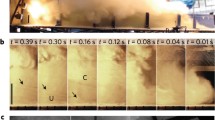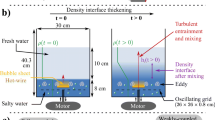Abstract
Ash flow deposits, containing up to 1000 km3 of material, have been produced by some of the largest volcanic eruptions known. Ash flows propagate several tens of kilometres from their source vents, produce extensive blankets of ash and are able to surmount topographic barriers hundreds of metres high. We present and test a new model of the motion of such flows as they propagate over a near horizontal surface from a collapsing fountain above a volcanic vent. The model predicts that for a given eruption rate, either a slow (10–100 m/s) and deep (1000–3000 m) subcritical flow or a fast (100–200 m/s) and shallow (500–1000 m) supercritical flow may develop. Subcritical ash flows propagate with a nearly constant volume flux, whereas supercritical flows entrain air and become progressively more voluminous. The run-out distance of such ash flows is controlled largely by the mass of air mixed into the collapsing fountain, the degree of fragmentation and the associated rate of loss of material into an underlying concentrated depositional system, and the mass eruption rate. However, in supercritical flows, the continued entrainment of air exerts a further important control on the flow evolution. Model predictions show that the run-out distance decreases with the mass of air entrained into the flow. Also, the mass of ash which may ascend from the flow into a buoyant coignimbrite cloud increases as more air is entrained into the flow. As a result, supercritical ash flows typically have shorter runout distances and more ash is elutriated into the associated coignimbrite eruption columns. We also show that one-dimensional, channellized ash flows typically propagate further than their radially spreading counterparts.
As a Plinian eruption proceeds, the erupted mass flux often increases, leading to column collapse and the formation of pumiceous ash flows. Near the critical conditions for eruption column collapse, the flows are shed from high fountains which entrain large quantities of air per unit mass. Our model suggests that this will lead to relatively short ash flows with much of the erupted material being elutriated into the coignimbrite column. However, if the mass flux subseqently increases, then less air per unit mass is entrained into the collapsing fountain, and progressively larger flows, which propagate further from the vent, will develop.
Our model is consistent with observations of a number of pyroclastic flow deposits, including the 1912 eruption of Katmai and the 1991 eruption of Pinatubo. The model suggests that many extensive flow sheets were emplaced from eruptions with mass fluxes of 109–1010 kg/s over periods of 103–105 s, and that some indicators of flow "mobility" may need to be reinterpreted. Furthermore, in accordance with observations, the model predicts that the coignimbrite eruption columns produced from such ash flows rose between 20 and 40 km.
Similar content being viewed by others
Author information
Authors and Affiliations
Rights and permissions
About this article
Cite this article
Bursik, M., Woods, A. The dynamics and thermodynamics of large ash flows. Bull Volcanol 58, 175–193 (1996). https://doi.org/10.1007/s004450050134
Received:
Accepted:
Published:
Issue Date:
DOI: https://doi.org/10.1007/s004450050134




